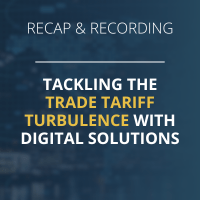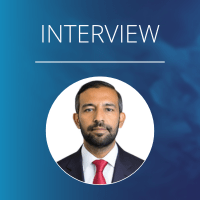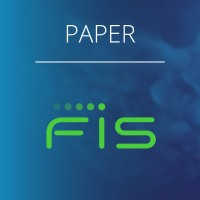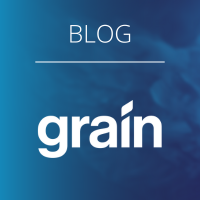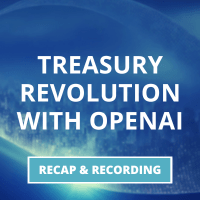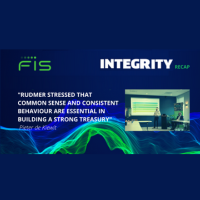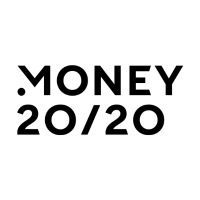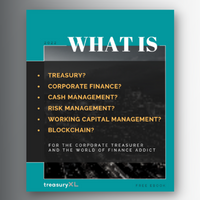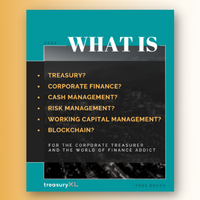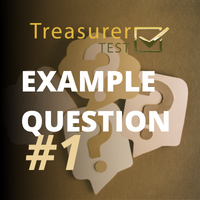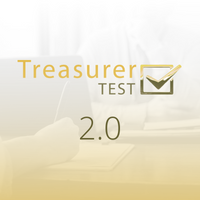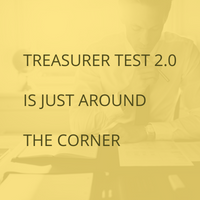Though Blockchain is not yet well understood by many treasury people, and tangible real-world applications for the corporate treasurer’s day-to-day activities are still scarce, this technology is getting increased interest in the treasury world.
Blockchain technology is however complex, and not easy to understand. There is still a lack of insight by many in the state of the technology and more intangible — but very real — aspects like operational, governance, and regulatory issues. Though there are still a number of challenges (technology & operational, security & privacy, and legal & regulatory) to overcome before allowing massive adoption, blockchain may bring a number of interesting benefits for the corporate treasurer.
What is Blockchain?
When discussing blockchain and distributed ledgers there is a lot of confusion. Both are often used as a synonym. When we talk about blockchain it is usually the technology that is used for Bitcoin. But not all distributed ledgers are blockchain-based. In fact there are many other distributed ledger technologies that use different methodologies (not only blockchain-based) to achieve consensus (e.g. Ripple, Ethereum, Hyperledger Project etc.). Blockchain is a decentralized, distributed, digital ledger (data base) consisting of digital records called blocks. These blocks are used to record and verify transactions across many computes.
When a block stores new data it is added to the blockchain. But in order for a block to be added to the blockchain, a number of things must happen:
Firstly, a transaction must occur. The next step is, that transaction must be verified. With blockchain, that task is left up to a network of computers. Once all of a block’s transactions have been verified, it must be given a unique, identifying code called a hash. Once hashed, the block can be added to the blockchain. When that new block is added to the blockchain, it becomes available for anyone to view or in case of a private blockchain to those that were allowed.
How to use Blockchain in a treasury environment?
There are a number of significant ways blockchain technology can impact corporate treasury:
- Cash management: Blockchain has the power to disrupt many aspects of this process; in investments, by reducing the time and resources necessary to insure investments are made when and where desired with limited (or no) human intervention; and in payments, by enabling a more efficient payment systems for corporates, whether to enable vendor payments or move cash internally.
- Credit: One of the trends in the wake of the financial crisis in 2008 was the significant build-up of cash on corporate balance sheets. Corporate treasurers are tasked with the offsetting goals of highest returns with least risk. The development of blockchain-based systems that enable P2P lending may be exactly what is necessary to achieve that dual mandate.
- Money: Banks are developing highly specific products on a private blockchain designed to represent specific values of fiat currencies and not to have their own underlying market. For treasurers, this means it is critical that better cash management information is available internally, as well as proper investment and payment guidelines are put in place for the future. The benefit will be reduced risk of non-market loss.
What are Blockchain activities for the corporate world?
The focus of blockchain developers is now turning from proof of concept projects to the creation of more practical, treasury-focused blockchain solutions. Recently we have seen a number of blockchain-based treasury trials that are worthwhile looking at. One of the solutions that triggered most is Smart Treasury by Boston-based fintech Adjoint. This solution is aimed to enable real-time gross settlement and continuous reconciliation and improve the liquidity management of the corporate treasurer.
Adjoint’s Smart Treasury contains a number of unique specifics that makes it very interesting for corporate treasures. This solution should be seen as a multi-bank, multi-currency virtual account platform for real-time gross settlement and continuous reconciliation. This should allow corporate treasurers to untap liquidity in their various subsidiaries’ bank account. Adjoint has combined blockchain technology with related smart contracts and APIs (or application programming interfaces) to create a solution that aims to dramatically speed up settling intercompany transactions in a secured way while significantly reducing the costs.
But also other new but interesting blockchain-based initiatives for corporates esp. the treasury department have been announced including those of platforms like Corda, Factom, Hyperledger Fabrik, Ripple and many more.
Why Blockchain for the corporate treasurers?
Internationally operating corporates have undergone many transformations in their finance and treasury organisations triggered by technology innovations, regulatory initiatives and changed client behaviours. As a result today’s business environment for these corporates is highly complex from a treasury point of view.
In the digital era, real-time insight into a company’s global cash positions and managing credit facilities across all bank accounts of the group and the ability to move money intraday to where and when it is needed is increasingly needed to support this changing business environment. Today’s model of international correspondent banking however does not easily facilitate the ability to manage cash in a real-time environment.
Corporate treasurers are urgently looking for new ways to provide cash management with up to date – and if possible real time – information on cash positions and cash forecasts faster and with deeper insight, allowing corporate treasurers to better react to the company’s current cash and working capital needs. Blockchain could be of great help to speed up and streamline their company’s cash, liquidity, risk and working capital management.
Frequently asked questions
What may blockchain bring for corporate treasures?
Auto reconciliation
Blockchain technology could be used to auto-reconcile transactions information, thereby eliminate netting processes and improve FX management to provide treasurers with streamlined efficiency and improved, real-time visibility on cash positions.
It could also enable limitless number of virtual or “sub-accounts” for reconciling customer and suppliers payments. Companies can thereby consolidate costly, physical bank accounts into a selected number of blockchain virtual accounts, thereby using smart contracts to designate how much and where digitised cash can be spent from these virtual accounts.
In-house self-service bank
This technology could also enable the creation of an “always-on” in-house self-service bank with “pre-established” rules for automated intra-company transactions. Here you could think of limits on how much can be automatically borrowed by entities based on pre-established interest rates. Nowadays, intercompany transactions, often conducted via an in-house bank, have become essential for multinational corporations. They seek to leverage internal resources more effectively. However, the overnight batch systems most companies use to settle transactions, can limit the transparency into subsidiaries’ account balances.
Smart contracts
Another key feature of blockchain technology is the use of smart contracts. Helping teams define and set pre-configured rules that securely enable automated, real time transactions. These may include key corporate treasury functions such as regulatory and corporate compliance requirements including KYC; account opening or transactions such as intercompany loans, FX and netting, manage liquidity in multiple currencies, transfers among any approved entities etc. so lowering the costs of booking transactions between subsidiaries.
API integration with corporate ERP and TMS systems
And there are increasingly so-called API-based blockchain offerings that allow fast integration with companies existing systems. Instead of replacing systems such as enterprise resource planning (ERP) and Treasury management system. This may improve the way they interact by speeding up intercompany transaction settlement. Through using smart contracts, all transaction information is auto-reconciled and automatically posted into treasury management systems in real-time.
API integration with banks
They may also allow a real-time API-based integration with banks for transactions outside the organisation. The solution allows the use of APIs for real-time intra-day bank transactions processing as opposed to end of day batch processing. They enable the transfer of critical information and data between corporate entities and their banks and data providers, as well as between corporate entities within the corporate.
What benefits may blockchain technology bring?
Blockchain could bring a number of important benefits for the corporate treasurer thanks to greater transparency, improved efficiency in current treasury processes, reduced risk en as a result much lower costs.
Optimise liquidity management
First of all it will allow for improved liquidity management thanks to greater transparency, allowing greater control over key treasury workflows. Blockchain has the potential to enable real-time insight in a corporate’s liquidity position and in how quickly they can provide liquidity to the corporate. It will enable treasurers to see balances across the corporate group, across multiple entities, corporate departments and banks (accounts), in different geographies, and at any point in time.
This visibility may expand to partners, subsidiaries, vendors and customers allowing them access. The insight gained may help drive more reliable cash flow forecasts for corporate treasurers. It further facilitates companies’ ability to more effectively allocate/use liquidity in functions such as supply chain finance, refinancing etc.
Optimise reconciliation process
Blockchain may significantly reduce current complications in the various treasury processes, including cross-border payments and billing. Using smart contracts could thereby streamline present cumbersome processes and eliminate costly third-party transactions. As it allows tracking transaction status and confirmations in real-time, thanks to the greater transparency brought about by blockchain technology between the various players, much less controls for transfer activities will be needed. Such transfers can as a result be done much quicker and in some instances even instantly, thereby optimising the whole reconciliation process across various subsidiaries ERPs in terms of time spent and manual effort.
Shorten settlement cycle: eliminate netting process
By removing the long chain of disintermediation (limiting risks and costs, while solving documentary compliance issues), blockchain allows outside companies within the supply chain to pull relevant information directly from the blockchain with no settlement network in between. This may create significant collateral savings thanks to shortened (or even instant) settlement cycles. Intra-group obligations may be settled instantly and at no cost.
Greater control: auditability
Blockchain-based solutions will also enable full-auditability of transactions, thereby realising greater savings in both time and costs. Such immutable auditable record of transactions may for instance provide real-time ownership of underlying cash, so there will be no double spending of cash. Also intra-company loans are auditable “for arms-length transaction history” by time-stamping reference able FX conversion rates.
Improve risk management
And there is also increased capacity for improved risk management. As the credibility of debtors and creditors is supposed to be known at all participants it will contribute to more security, while blockchain will also enable secure data storage across nodes to prevent a single point of failure
Cost reduction
All these improvements could ultimately lead to a firm reduction in costs. Large savings could thereby be got from transaction costs and labour costs (esp. back office), while corporates could significantly reduce fees and costs to third parties.
What could it bring strategically?
But also from a financial and business strategic point-of-view, blockchain could bring a number of great benefits. Having a clear and real-time picture of assets and cash flows, finance has the ability to make strategic investments in a shorter period of time, helping to capitalize on potential investment opportunities and evaluate important future transactions, thereby expanding the types of transactions that can be done.
In international operating companies, smart contracts may help the Treasury play a critical role in successfully conducting business overseas. This may range from payment strategies, deeper vendor and client integration and purpose-driven liquidity allocation.
Conclusion
Blockchain has the potential to transfer the effectiveness of corporate treasuries and its strategic value for future complex business decisions. This thanks to the real-time visibility of cash flow positions across multinational entities and the position to provide a single view of consolidated cash flow in real time. This may give the corporate treasurer the time to focus more on making strategic decisions to fully support the business.
 https://treasuryxl.com/wp-content/uploads/2024/10/Carlo-_BLOGS-Expert-featured-2.png
200
200
treasuryXL
https://treasuryxl.com/wp-content/uploads/2018/07/treasuryXL-logo-300x56.png
treasuryXL2025-10-29 07:00:302025-10-27 17:49:16GENIUS and CLARITY ACT: US Financial Institutions entering the digital space
https://treasuryxl.com/wp-content/uploads/2024/10/Carlo-_BLOGS-Expert-featured-2.png
200
200
treasuryXL
https://treasuryxl.com/wp-content/uploads/2018/07/treasuryXL-logo-300x56.png
treasuryXL2025-10-29 07:00:302025-10-27 17:49:16GENIUS and CLARITY ACT: US Financial Institutions entering the digital space

